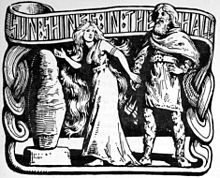Alvíssmál
This article may need to be rewritten to comply with Wikipedia's quality standards. (March 2013) |


Alvíssmál ("Talk of Alvíss") is a poem collected in the Poetic Edda, probably dating to the 12th century, that relates a conversation between Thor and a dwarf called Alvíss ("All-Wise").
Plot
Alvíss comes to Thor to claim Thor's daughter as his bride, saying that she had been promised to him earlier. Thor refuses as he had not been at home at the time, then tells Alvíss that he may take the young woman if he can correctly answer all of Thor's questions. The dwarf's replies act as an exhaustive list of the sentient mythological entities among men, Æsir, Vanir, giants, dwarves and elves. For example, the sky has the following names, according to Alvíss:
|
|
Alvíss succeeds, but is turned to stone when touched by the light of the rising sun. This makes it highly unusual among tales focused on Thor, as he was normally depicted as solving problems using physical force rather than his wits.[citation needed]
Dating
It is not known when Alvíssmál was created; analysis of its contents can point to multiple periods depending on which elements are focused upon. One theory is that the use of Thor and references to mythical beings can be assumed to reflect the culture's religious beliefs,[citation needed] so it would have been created no later than the 10th century before Iceland was Christianized. Another points to the presence of words found only in late skaldic poetry, which would indicate that it came from the 12th century skaldic poetry revival.[1][2]
References
- ^ Jan de Vries, Altnordische Literaturgeschichte volume 2 Die Literatur von etwa 1150 bis 1300, die Spätzeit nach 1300, Grundriß der germanischen Philologie 16, 2nd ed. Berlin: de Gruyter, 1967, OCLC 715891742, pp. 110–13 Template:De icon
- ^ "Alvíssmál", Rudolf Simek and Hermann Pálsson, Lexikon der altnordischen Literatur, Kröners Taschenausgabe 490 , Stuttgart: Kröner, 1987, ISBN 9783520490018, p. 9 Template:De icon
External links
English translations
- Alvissmol Translation and commentary by Henry Adams Bellows
- Alvíssmál Bellows' translation with clickable names
- Alvísmál Translation by P. B. Taylor and W. H. Auden
- Alvíssmál A Comparative Study
- Alvísmál Translation by Lee M. Hollander
Old Norse editions
- Alvíssmál Sophus Bugge's edition of the manuscript text
- Alvíssmál Guðni Jónsson's edition with normalized spelling
